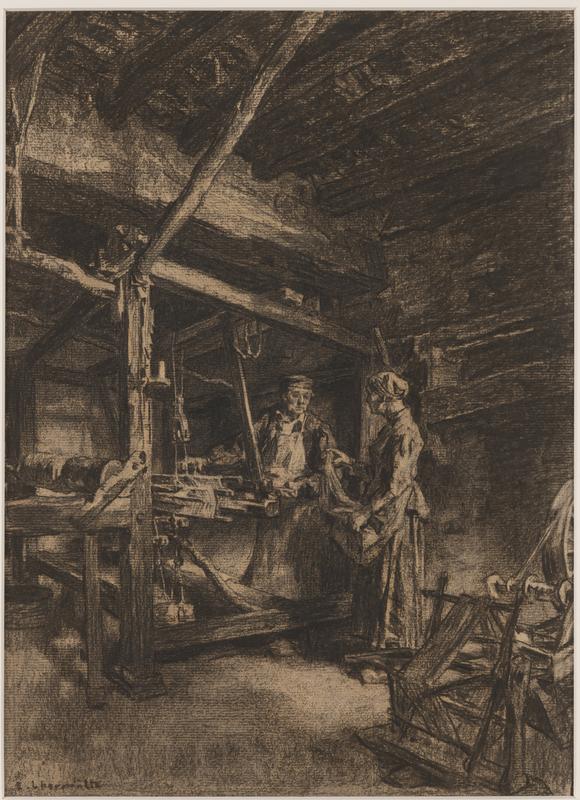
117. Léon-Augustin Lhermitte, The Weaver
| Artist | Léon-Augustin Lhermitte, French, Mont-Saint-Père, Aisne 1844–Paris 1925 |
| Title, Date | The Weaver (Le tisserand), 1887 |
| Medium | Charcoal highlighted with white chalk |
| Dimensions | 15 1/4 × 11 1/8 in. (38.7 × 28.3 cm) |
| Inscriptions + Marks | Lower left: L. Lhermitte |
| Provenance | Sale, Hôtel Drouot, Paris, October 31, 1973, salle 7, M. Laurin. Sale, Hôtel Drouot, Paris, January 23, 1974, salle 10, M. Ader, no. 28. [Paul Prouté S. A., Paris, until 1974; to Weisberg]; Yvonne and Gabriel Weisberg, Minneapolis (1974–2022; given to Mia) |
| Exhibition History | "Les fusains de L. Lhermitte," Librairie Artistique, Launette, Paris, 1887; "The Quieter Image: 19th Century European Drawings and Watercolors," Carleton Art Gallery, Carleton College, Northfield, Minn., 1996, no. 33; "Expanding the Boundaries: Selected Drawings from the Yvonne and Gabriel P. Weisberg Collection," Mia (2008) and Snite Museum of Art, Notre Dame, Ind. (2010); "The World at Work: Images of Labor and Industry, 1850 to Now," Mia, 2012; "Reflections on Reality: Drawings and Paintings from the Weisberg Collection," Mia, 2022–23 |
| References | Monique Le Pelley Fonteny, "Léon Augustin Lhermitte (1844–1925): Catalogue raisonné" (Paris: Éditions Cercle d’Art, 1991), p. 412, no. 486; Lisa Dickinson Michaux with Gabriel P. Weisberg, "Expanding the Boundaries: Selected Drawings from the Yvonne and Gabriel P. Weisberg Collection" (exh. cat.), Minneapolis Institute of Arts (Minneapolis, 2008), pp. 48–50, fig. 29 |
| Credit Line | Gift of Dr. Gabriel P. and Yvonne M.L. Weisberg 2022.80.1 |
Léon-Augustin Lhermitte made this drawing at a time when cottage industries such as weaving were facing intense competition from mechanized factories. It was a serious social concern across northern Europe, one Lhermitte helped humanize with this portrayal of traditional artisans. By taking a low vantage point, he revealed the massive timbers of this workshop, as if to convey a sense of the deep history behind local craftsmanship. The spinning wheel and treadle loom have likely provided this family’s livelihood for generations. Lhermitte added to the dignity of the scene by portraying the space as orderly and the couple as absorbed in the day’s work: the woman appears to show the man some wool or flax that she will spin into the threads that he will weave into cloth. The product of their labors slowly accumulates on the big roller near the man’s feet. In some drawings, Lhermitte detailed his figures so precisely that you feel you could recognize them on the street, but not here. The man and woman are presented less as individuals than as generalized types, emblematic of a whole class of traditional artisans threatened by the Industrial Revolution.
Lhermitte’s confident draftsmanship is on full view. We can almost see the movement of his hand as he marked out the beams and poles that give the scene its dramatic perspectival structure. Lhermitte occasionally searched for a line, trying a couple of possibilities before forcefully going over the one he wanted. The finest of his strokes mark the spaces between threads on the loom; heavier marks define the ancient timbers. He then used endlessly varied strokes to articulate lighting and texture. Gradations of light were produced by applying charcoal with the side of his stick and then smearing it. The light comes from a door or window behind Lhermitte and to his right. In his hands, it enters the room as a benediction.
TER